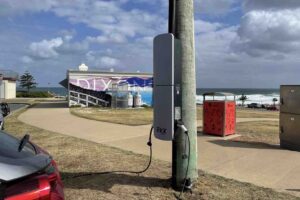One of the often-discussed issues in energy economics circles is the scope for EV charging, with its large loads, to make households more responsive to prices.
Greater responsiveness to prices suggests less upstream expenditure, better utilisation of capital and hence, potentially, lower prices.
Or so the welfare economics theory goes. Regulators and some economists are “passionate” about this and see it as their life’s work to make prices “cost reflective”.
I have recently decided to upgrade from a plug-in hybrid car to an EV and so looked for the best charging offer. Did I find “cost reflective” tariffs that will make me more responsive to wholesale prices?
I did not need to look far to find fascinating information. My own retailer has an electricity “plan” that will charge my car for 8 cents per kWh if I plug in between 0h00 and 6h00. As part of the plan they will also pay me 10 cents for each kWh that I feed into the grid from my PV (the regulated minimum is 4.9 cents) and a single rate for all other times that is a smidge higher than the Victorian Government’s “default offer” price.
Well, this is amazing. I will be worse off using my own PV to charge my car rather than to export my PV production to the grid. I would never have thought such a thing possible with feed-in rates that are not subsidised.
There is more. It might have struck you as strange that the cheap EV charging period does not correspond to the time of abundant solar. We have all heard about the “duck curve”. Long a thing in South Australia, it is now a thing in all the NEM’s markets except Tasmania.
Indeed we see this mid-day abundance in the wholesale prices. The average 5-minute wholesale (spot) price from 0h00 to 6h00 on all days for the year to 18 September 2023 (i.e. the average for those 26,280 five minute periods) in Victoria is 7.8 cents per kWh. But between 10 and 2pm it was just 1.6 cents per kWh.
So why is my retailer not encouraging me to plug in then rather than between 0h00 and 6h00? This is the obvious thing to expect, and the regulators (and often economists) are deeply wishing to see such load shift into the middle of the day to bring the duck’s belly up and its head down.
Let’s try a few answers. Customers with EVs are likely to prefer to start the day with a charged battery so will value an over-night charge more than a mid-day charge. Perhaps also my retailer thinks that many cars will not be at home to be charged in the middle of the day, so why offer something that will only have a few customers?
Contract markets, and the fact that my retailer is likely to rely on those markets (they do not own their own generation) is also likely to be part of the explanation. For the year ahead I estimate my retailer can secure contracts for around 6 cents/kWh per kWh for electricity supplied between 0h00 and 6h00.
But for supply during the 10h00 to 14h00 period they are likely to need to hold both “Base” and “Peak” contracts to hedge their exposure to spot prices. That brings the contract price to around 9 cents per kWh for supply at such time.
So, they can offer a comparably hedged price that is lower for supply between 0h00 and 6h00 than between 10h00 and 14h00, despite the fact that the spot prices point in exactly the opposite direction.
Contract prices might also go some way to explaining how my retailer can offer me 10 cents for my PV feed-in when the average spot price in the 4 hours that PV feeds most of its electricity back into the grid was just 1.5 cents in the last year.
Specifically, the avoided cost to my retailer of not buying my solar is not 1.5 cents – they don’t buy from the spot market – but rather the capped price of around 9 cents. Note to regulators: something to think about here next time you set minimum feed-in rates.
Finally let me also note that for my EV charging, my retailer also bears a network charge of 10 cents per kWh to pay Jemena to deliver the electricity to me.
Amazingly my retailer is bearing this (presumably they expect to get this back on the margin on the electricity they sell me later in the day). Wow. Can you imagine a tightly regulated market delivering such outcomes? Regulators would allow such things over their dead bodies.
But this is a market in action in the real world. Very different from what might be discussed in the class room of price/quantity charts assuming perfect competition.
So next time you engage in debate about duck curves, wholesale prices and customers’ responsiveness to prices, bear in mind that in reality the picture might be very different from what you expect from pre-conceived notions of how markets work and your bounded rationality. This was certainly the case for me.
Finally, I can’t say which car I chose, but I can say the search was fascinating. What huge progress in such a short time. The last time I had a proper look at the EV market was as part of an advisory panel to the Victorian government, a couple of years ago. Since then much has changed.
The lithium iron phosphate battery (rare two years ago) in my chosen car can be expected to lose just 15% of its capacity after a million kilometres. This chemistry also relieves me of my concerns about stimulating demand for cobalt supply from the Congo and nickel from Russia.
The service costs for my car for 80,000 km (two services over this period) will be a touch over $1000 in total and I estimate it will cost me around $1.2 per 100km to run. Diesel or petrol cars are now around 20 times as much.
The fringe benefit tax concessions are remarkable and the car I have chosen is, I think, 9/10th of the market leader for 6/10th of the price.
Who anticipated such things, I didn’t? What else lies ahead that we have not had the imagination to conceive of?
There is much to grumble about, but developments in EV markets, aspects of Australian EV policies, and retail electricity markets deliver much hope for a rapid energy transition, and much food for thought.
Professor Bruce Mountain is the Director of the Victoria Energy Policy Centre








